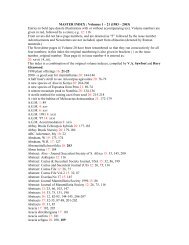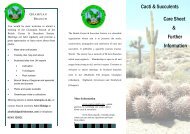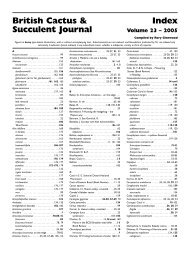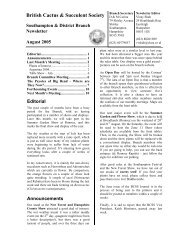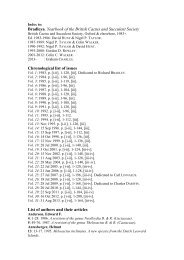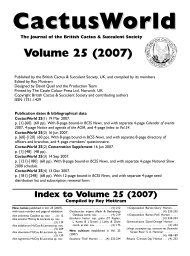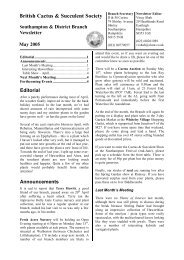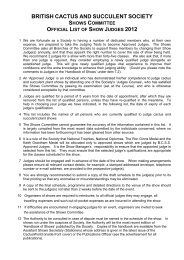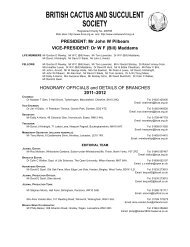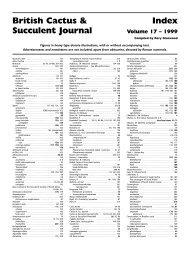December 2011 - southampton.bcss.org.uk - British Cactus ...
December 2011 - southampton.bcss.org.uk - British Cactus ...
December 2011 - southampton.bcss.org.uk - British Cactus ...
Create successful ePaper yourself
Turn your PDF publications into a flip-book with our unique Google optimized e-Paper software.
<strong>British</strong> <strong>Cactus</strong> & Succulent SocietyBCSS Southampton & District Branch <strong>December</strong> <strong>2011</strong> Newsletter Page 1Southampton & District BranchNewsletter<strong>December</strong> <strong>2011</strong>Branch SecretaryDavid Neville6 Parkville RoadSwaythlingSouthamptonHampshireSO16 2JAdavnev@btopenworld.com(023) 80551173 or07974 191354Newsletter EditorVinay Shah29 Heathlands RoadEastleighHampshireSO53 1GUvvshah@clara.co.<strong>uk</strong>(023) 80261989Editorial ...........................................................1Announcements ...............................................1Committee Reports – <strong>2011</strong> .............................1President’s Report................................................. 1Chairman’s Report................................................ 1Secretary’s Report................................................. 2Treasurer’s Report ................................................ 2Display Manager’s Report .................................... 2Librarian’s report .................................................. 3Newsletter/Website............................................... 4Publicity Officer’s Report..................................... 4Plant Sales Officer’s Report ................................. 4Last Month’s Meeting.....................................4Plants of Interest ................................................... 4The Little Karoo.................................................... 5Table Show Results .............................................. 9Branch Committee Meeting ...........................9Table Show <strong>2011</strong> – Overall Results ...............9Next Month’s Meeting ..................................10Forthcoming Events......................................10EditorialAnother year has raced past, and Christmas is nowjust a few days away. The weather has continued tobe unseasonally warm, with just a hint or two offrost recently. In the past couple of weeks, I‘ve seenazaleas, roses, hydrangeas, fuchsias and marigoldsin flower. Hopefully our winter heating bills willbenefit from the mild November but of course thecoldest months still lie ahead.I stopped watering plants in my conservatory at theend of October, although the weather in Novembermeant I could (should?) have watered once or twicemore. Of course it is too late now and we may get afrost at any moment. A few mesembs continued toflower and the haworthias have coloured up nicely,but there’s not much else to report.AnnouncementsThe meeting in January will consist of short talkspresented by branch members, and we will haveaccess to both conventional and digital projectors.We’d like members to bring along photos or plants,and talk about them for a few minutes. Digitalpictures can be brought along on a CD or memorycard or memory stick, and should benumbered/prefixed 001, 002, 003 etc. to ensure theyare shown in the correct order.The Branch Programme for 2012 has beenfinalised and copies should be available from thefront table.Committee Reports – <strong>2011</strong>President’s ReportI want to congratulate the branch on another verysuccessful year. There is a good social atmosphereat meetings and this year especially there has beennew faces at most meetings.Well done to David and the committee for all theirhard work, however some more help is needed withthe catering and a new librarian is also needed.Consider getting involved with the committee, youget much more out of your membership if you do.So well done to all of you who support the branch ina variety of ways.Wishing you a Happy Christmas and a successfulNew YearPeter DownChairman’s ReportI am pleased to report that <strong>2011</strong> was anothersuccessful year. The attendance level has been verygood this year so thanks to everyone for theirsupport. Some of this must be due to the very goodspeakers that we have had, so our thanks must alsobe extended to our secretary David. It is also verysatisfying to be able to say that all the shows that wehave supported have done very well. So all in all avery good year & lets hope that the coming year isas good - or even better!Wishing you all the best for a Happy Christmas & aHappy & successful growing New Year.Geoff Card
BCSS Southampton & District Branch <strong>December</strong> <strong>2011</strong> Newsletter Page 2Secretary’s Report<strong>2011</strong> has been another successful year forSouthampton and District branch. We havemaintained our healthy attendance figures,welcoming a number of new members during theyear, and as always we are pleased to welcome ourfriends from Portsmouth branch who often pay us avisit. Once again we have received nothing butpositive comments from visiting speakers, who arepleasantly surprised by the number of people at ourmeetings. We make every effort to thank ourmonthly speakers; I usually take them out for a mealbefore the meeting, and in addition to paying theirtravel expenses we present them with a bottle ofwine to thank them for their willingness to travel totalk to us.The branch programme for 2012 is now completeand copies should be available at the AGM. A copyof the programme and the <strong>December</strong> newsletter issent to all of our members who are unable to attendthe AGM and Christmas Social meeting. I have triedonce again to put together a good mix of talks fornext year, and hope that we will enjoy someinteresting and entertaining presentations.The branch committee attributes much of thesuccess of the branch to the number of publicdisplays that we undertake, ensuring that we projecta strong image to potential new members.Unfortunately the number of events that we haveplanned for 2012 is fewer than we have staged inrecent years, but this is due to reasons outside of ourcontrol. For some years we mounted a display at theGarden Fair at Whiteley Village Shopping Outlet,but the site has now closed for redevelopment. Wehave also staged a 2 day display each year at the SirHarold Hillier Arboretum in Ampfield, but thegardens are now council owned and run, andbecause of falling revenues (presumably due to theglobal recession) they have decided only to stagedisplays that bring them a revenue, and so in 2012the display area will be used only for commercial artand photographic displays. For several years wehave also staged a display at the show of the SolentFuchsia Society in Titchfield, but they will not beholding a show next year because of a virulent newpest, the Fuchsia gall mite, which has arrived in theUK, and which is currently most prevalent inHampshire. Already this pest has spread intooutdoor, hardy fuchsias in the area, and as it isvirtually uncontrollable the society members arewondering if they are going to be able to growfuchsias at all in the future! We will still howeverhave a presence at the 3 largest shows that weregularly attend, these being the Countryside Day atSparsholt Agricultural College, the New ForestShow, and the Romsey Show.The branch committee is always looking for newways to promote our meetings and activities, so ifanyone has any suggestions of other events that weshould attend to promote the BCSS we would bepleased to receive your ideas. Similarly, if you canthink of any ways in which we can improve orenhance the monthly meetings we would bedelighted to consider them.In closing I would like to thank everyone for theirhelp and participation throughout the past year, andI wish you a prosperous and successful 2012.Treasurer’s ReportDavid NevilleUnfortunately I am unable to attend AGM in person,as my baby is due at the end of the month. Despitedifficult economic conditions, branch finances haveremained stable and we have managed to break evenwhilst continuing to allow members to attendmeetings for free. This is thanks to all of us throughcontinued support of the raffle, plant sales,refreshments and taking part in shows.Our Branch has taken part in five shows through thesummer which raised £345. Profit was downcompared to last year, mainly due to increased costsin attending the New Forest Show, but this has beenbalanced by good profits from other shows and £80prize money won at Romsey. Thank you toeveryone who has taken part in these events.The cost of visiting speakers has increased. On theother hand, the branch received additional incomefrom sales of donated plants and books, (thanks toRoger & Linda, Ian, Philip) which was greatlyappreciated. We have even been able to purchase thenew Aloe book for the library. Going forwards, wewill save £40 a year as our web hosting fees willnow be paid by the National Society.Wish you all the best throughout the festive seasonand hope to see you all next year.Display Manager’s ReportAlice JankovecSparsholt Countryside Day 14th MayOn Saturday 14th May, we held our first display of<strong>2011</strong>. We were not too sure about the weather so Idecided to use my gazebo since the branch gazebo isnot waterproof. But when we tried to put it up I
BCSS Southampton & District Branch <strong>December</strong> <strong>2011</strong> Newsletter Page 3realised that one of the roof bars was missing so wehad to use the branch one after all. We werefortunate with the weather but it was a bit breezyand not very good for sitting out. The College put ona very good event with plenty of interesting thingsto see and I think that all branch members whoattended had an enjoyable time. During the Octoberheatwave I decided to make a new bar for mygazebo - after cutting and filing a metal rod to fit, Idiscovered the missing bar - it had got jammed intoone of the legs!Hilliers Branch Display 21-22 MayThis year we were lucky to have our display in theentrance to the Gardens. This combined with an ArtTrail in the garden and a lovely sunny day madeSaturday one of the best days we have had for plantsales and visitors to the display. On Sunday theweather was not as nice and this affected the numberof visitors to the garden and our plant sales, but itwas well worth doing. I hope we will get invited toput on a display in 2012.The New Forest Show 26-28 JulyI am pleased to say the weather was like last yearfinefor the three days with just the occasionalshower. Our display was again in the main marqueebut this time we had an island site. At first I thoughtwe would be tight for space but it turned out we hadspace behind the display to store sales plants. Thisyear we had a larger display and I was a bit worriedwe would not have enough plants as BruceBeckerleg had broken his arm and was unable toattend. But we had more plants than normal as TedSmith and Tony Gretch brought plants and Brucealso sent some. This helped me a lot since I was ableto take some of my plants home, leaving more spacefor when we packed up. One of the disadvantagesthis year was that we had to pay for extra ticketssince we were only allowed 2 free tickets for eachday, and we need at least three to man the stand anddisplay. Our display won a silver gilt award but asthere isn’t any prize money it did not help our funds.Solent Fuchsia Show 30 JulyThis was held in the Community Hall at Titchfield.This is only a small display with David, Ted andTony helping put up the stand and supplying plants.It was easy to man and <strong>org</strong>anise the show, but theydid not get as many visitors as they had hoped andour plant sales weren’t very good. Fortunately it’san easy show to do and I always enjoy it. TheFuchsia show was very good and the main problemseems to be lack of publicity which is a shame sinceit deserves more visitors.The Romsey Show – 10 SeptemberWe were again asked to put on a display atBroadlands. I was a bit worried this year as David,Geoff, Dot and Ted would be away during the show.Fortunately, Bruce and Tony were able to bringplants for the display and we were able to put on agood show. Friday morning when we were loadingthe car, the weather was showery, but by the timewe arrived at the marquee it was sunny and we soonhad the stand ready. On Saturday, Bruce, Tony, Jimand Ciprian arrived to sell plants and man the stand,and I am pleased to say we won a gold medal whichwas worth £80 towards branch funds.The branch Table Show had a few new membersenter this year, which was good to see. I hope evenmore members will enter in 2012. Do not f<strong>org</strong>et youcan make more than one entry per class.I would like to thank Ian Acton for all the plants hedonated to sell at the Shows, and to all the memberswho helped me at the shows - and also my brotherPeter for all his help.Merry Christmas and a happy new year to you all.Librarian’s reportIvor BiddlecombeThe level of borrowing this year was much the sameas last year. A stock take was undertaken at theJanuary meeting. There were some titles missinghowever these were easily recovered having beenplaced in storage, and therefore not in cupboard andavailable for borrowing.From this experience it would seem sensible to doan annual stock take. I will do a stock take eachJanuary as a routine.A large number of books were donated by PhilipClemow and by the estate of a deceased member.Some were sold, others remain in storage to beavailable for sale at future meetings, and a few willbe added to the library stock. The sum from the saleof these books is shown below.One new book has been purchased. Aloes: TheDefinitive Guide by S Carter et al. and this has wellborrowed.Revenues for the year ending September <strong>2011</strong> wereas follows:Lending £ 9.00Sale of books £ 99.50Total £108.50Dorothy England
BCSS Southampton & District Branch <strong>December</strong> <strong>2011</strong> Newsletter Page 4Newsletter/WebsiteDuring this year we have continued with the idea ofgetting people to wear small name badges at ourmeetings, and I hope this makes it easier for newmembers to join in and mix with everyone.I produce around 35 newsletters each month andsometimes these do run out, so I would like toremind everyone that newsletters can be viewed ordownloaded from our website. If you need a printedcopy of any back issues, just let me know. Thesupply of snippets seemed to dry up this year but I’llthank those of you who did submit something forpublication. Please continue to keep your eyes openand send me articles that might be of interest toother branch members.Hall floor damage forced us to cancel the Octobermeeting. I try and update the website with any suchnews as soon as it is known, so to avoid wastingtime and making an unnecessary journey, I’d adviseeveryone to try and check the branch website on theday of the meeting – especially if the weather isquestionable.We only sold a couple of badges this year, and I’dlike to remind newer members that we do have anice gold-plated enamel badge featuring the branch,available for £2 (or £3.50 for two).Best wishes to everyone for 2012,Publicity Officer’s ReportVinay ShahFirst of all, as usual, my thanks to all who have inany way contributed to publicising the branch andits activities. We have finally got into the Echo on 2consecutive months, so let’s hope this continues.Radio Solent continues to give us regular support ontheir What’s On spot. I am putting up more postersin the libraries if they will agree, as most that werepreviously displayed have now been taken down.Finally, seasons greetings to all and good growing in2012.Jim RoskillyPlant Sales Officer’s ReportThe Season started off with a small display atSparsholt which I missed last year. We took £340which was good for just one day. Next was Hillierswhich we did not do last year, where we took £486.The New Forest Show was up on last year withtakings of £965 but this is still a bit below averagefor this event. I do not go to the Fuchsia Show butwe do not normally sell very much there.We did the Romsey Show for the second time wherewe took £358, well up on last year, added to whichwe got £80 in cash for a gold medal.Sales at branch meetings continue to be buoyant,partly because we continue to have higherattendances than we used to but also because wehave more sellers which has added extra interest tothe sales table.I would, once again like to thank all of you whobrought sales plants to the various events and alsothose, Ian Acton in particular, who made donationsof sales plants.For those of you who do not know, anyone canbring plants for the sales table, just make sure eachplant has a price label with your initials on. Wecharge a 10% commission at branch meetings and15% at shows.Last Month’s MeetingBruce BeckerlegThe meeting started with a presentation of a gift toIvor from the branch – for all the cakes he makes forthe monthly meetings, committee meetings andshows – without him ever accepting payment for theingredients or the effort involved.The gift was a plant which David described as aJapanese variegated small-growing Agave. It hadbeen bought at ELK, the plant was some 8 inchesacross and the label was marked Agave potatorum v.marginata.Plants of InterestIt was also Ivor who had brought along some Plantsof Interest. The first group consisted of mesembs inflower – these were Conophytum herreanthus (whiteflowers), Conophytum truncatum (yellow flowers),Conophytum spectabile (feathery pink flowers) andConophytum obcordellum with pink flowers. Thefifth was a Faucaria.Ivor mentioned that when he does displays, he oftenbrings along young plants which look good througha magnifying glass since some children find this afun activity. Today he had brought along somemature plants which had interesting spination. Theseincluded Mammillaria crucigera, Mammillariaschiedeana, Mammillaria moelleriana, andMammillaria chionocephala.
BCSS Southampton & District Branch <strong>December</strong> <strong>2011</strong> Newsletter Page 5He had also brought a couple of examples ofMammillaria carmenae – one with white spines andthe other with brown spines. You can also getalmost any shade in between. Next were four formsof Mammillaria albilanata – the standard plant iswhite-spined but there are several named varieties.Next was Mammillaria theresae. This produceslarge 1.5" flowers and Ivor described how he hadnursed a small plant of only 2 heads into a muchlarger example. It seemed to do better when hemoved it from a plastic pot into a clay pot. The finalplant was a Mammillaria plumosa, an offset savedfrom a plant which had once filled a 12 inch pan butwhich had subsequently died. The unusual thing wasthe diameter of this single head – normally it wouldhave started to offset at a much smaller size.The Little KarooGeoff introduced our speaker, Rodney Sims, whowas going to talk about the Little Karoo. Rodneycommented it was nice to see so many people at themeeting – he was used to smaller audiences. Hestarted by asking how many people knew where theKaroo was? A few members raised their hands.He explained that botanists in South Africa haddecided to study the variations in the flora, and thedifferences in the number of plants in differentregions, and this led to the creation of several plantzones. The first slide showed a map of the generalregion. The Karoo is an area with reduced rainfall inthe lower centre of the country. Some areas getwinter rainfall while the centre gets summer rainfall.The Little Karoo (Klein Karoo) was a specific areato the south of the main Karoo. There is a mountainrange along the bottom which controls the rainfall inthe area, and further mountains on both sides,including the large black mountains, the GrootSwartberg. Along the bottom are the Langeberg andOuteniqua ranges. So overall, you have an area of ahighish plateau between a number of mountainranges.Initially they would travel to Montagu through theRooibergs and then on to Oudtshoorn andSchoemanshoek, and then up through the Swartbergpass. Rodney showed a pilot’s map which showedthe ranges of mountains. There was sea to the Southand dry continent to the North. Wet winds come infrom the Antarctic, hit the mountains and themoisture condenses out, usually on the seaward side.This causes a rain shadow on the landward side ofthe mountains, creating an environment forsucculent plants. The soil is shallow and often red incolour. In the West, the rainfall is 150mm, and inthe East it gets to about 450mm. You can often get a50% deficiency in the amount of rain, so the plantshave to be capable of surviving this. Thetemperatures range from 0°C to 50°C – in otherwords, blooming cold to blooming hot.He stated that over the years, since it has beenknown to us, the little Karoo has been overstockedwith animals. Previously, the natives - the San andthe Khoisan - lived in balance with the land. Heshowed us some interesting cave paintings from theregion, including one which perhaps featured anAloe ferox. White farmers introduced intensivefarming and there were 48 million sheep raised in anarea that should have supported 7 million, leading toover grazing. One of the other big problemsintroduced by the white man was Ostrich farming.These birds eat every piece of vegetation they cansee, so no vegetation is left in their compounds, andwhen the rains come, there is a lot of erosion. Also,ostriches weigh up to 360kg - and have feet whichare 6 square inches in area - so this means they exerttremendous pressure on the ground, destroying andcompacting the soil structure.When flying into the area, if you’re lucky you mayhave an East facing seat on the plane and it is nice tosee the sun coming up. Through the mists you caneventually see the land and structures on the ground.He showed an aerial picture of a bend in a river,some rapids, sand banks and a water fall and farmtracks, but said that he had never been able to locatethis on a map. Ian Acton said that if they were dryrivers, it might be the region of South Africa that isnorth of Augrabies and which sticks up betweenNamibia and Botswana.They got to Cape Town and then went to Montaguwhich was a typical colonial town. We saw a pictureof the impressive bank. They were staying at theMontagu Country Inn, where they were welcomedwith “bucks fizz” and a live pianist playing in thedinner room, so it was real luxury. A lot of thetowns spell out their name on the hillside usingwhite stones. They are proud of their colonialheritage and there was a colonial trail. Their groupconsisted of 4 Brits and 2 South Africans, includingJan Vlok who was to be their guide. Jan is theauthor of a recent book called Plants of the KleinKaroo.Their first stop yielded Gasteria bayeri with a 3 inchleaf span. Rodney mentioned that in South Africathere are large numbers of species and families ofparasitic plants - and we saw Cytinus sanguineuswith flowers which were red balls one cm across –the plant itself would be feeding on the roots of thehost. We also saw masses of blue daisies, Felicia.Adromischus maculatus showed superb coloration.
BCSS Southampton & District Branch <strong>December</strong> <strong>2011</strong> Newsletter Page 6Next was a geophyte, possibly Euphorbia crispa orsomething similar. It will have a big caudexunderneath and is not easy to grow in cultivation. Inparts of South Africa, grasses are replaced byrestios. Bulbines are not easy to identify but we sawwhat might be Bulbine aloides. A splash of redrevealed the thin stems of a Microloma (anasclepiad) which is an interesting twining plant.Stapelia rufa had a flower 2 inches across – it isquite uncommon to find them in flower. Hyobancheglabrata is another parasite. It has smallzygomorphic flowers with beautiful colours. Wherethere is a vegetative matter you can get fires and thisis a major destructive and constructive force in thisarea. Driving along, they suddenly saw a splash ofcolour and this was Aloe variegata in flower. Inhabitat you rarely see them with more than 6 leaves.The stems of Euphorbia juglans looked like largewalnuts. It shrinks and fills back out again and youcould see that it had pushed the soil out around it.We saw Antigibbaeum fissoides and the epidermisof older leaves had been colonised by some sort ofalgae or bacterial growth. Next was Avoniapapyracea, with pieces of white flint in the soil. Ifyou find this type of quartz, you will usually findother interesting plants too. Adromischus filicaulisv. marlothii again had old leaves that wereblackened by the algae. There were some shrubletswhere the cambium is down the inside of the stem –effectively an inside-out bush. In amongst the treesand bushes were one or two plants. Gibbaeumpubescens was growing in the quartz patches and itwas a fantastic sight in flower. Unfortunately thisarea was soon to become a safari park. We also sawa green Gibbaeum cryptopodium – the name meanshidden foot. These plants had apparently beennibbled by tortoises. Crassula tecta used to be verypopular in cultivation and it was very beautiful. Wealso saw Crassula pyramidalis in flower. The plantwas about 2 inches high and the leaves were verydensely packed. It is monocarpic, so would die afterflowering.Inside the fence was a Quaqua, which is one of thehard tubercled Carralumas, with creamy yellowflowers – this was Q. marlothii. They again foundthe Antigibbaeum – you can see some of theseplants along the roadside, so there’s no need to askfor farmer’s permissions or to cross fences.Crassula deltoidea has angular leaves in the shapeof a delta and it was beautifully marked. They foundan Astroloba which may have grown under theshelter of a shrub – but when the shrub dies, theplant is exposed and starts to suffer. A stickEuphorbia was nicely marked but these are hard toidentify and he wasn’t sure of the species.They went through an open gate and after lookingaround, found Bulbine succulenta - barely one cmtall. Tucked away in a corner was the red floweredSutherlandia frutescens – known as kankerbos, it isused by the natives to treat cancer. David said it canbe found in health food shops. The flowers are 2inches tall and quite large, eventually going on toform spherical pink seed capsules, giving it thename balloon pea. Gibbaeum heathii was seeneverywhere. It has pink bodies with pink or whiteflowers. Gibbaeum geminum is one which grows inbranches in a cruciform pattern and the magentaflowers were starting to develop. There was ablurred outline to Gibbaeum pubescens and this wascaused by fine hairs. The plant sits down low buthad still been grazed by something.They moved on to the burn site, which had, withinthe last 6 months, had a fire. Some of the flowersbeginning to appear were Lapeirousia with whiteflowers on stalks 2-3" tall. Moraea ramosissima hadyellow flowers - it branches all over the place, and isa member of the Iris family. Oxalis obtusa had nicesalmon-coloured flowers, the colour varies fromwhite through orange to dark red. Babiana is a bulbwhich is called the baboon nut because they try anddig these up and eat them. It had a purple andyellow flower. A weedy looking plant had beautifulflowers – the genus was Nemesia. If it was a newspecies, it should be called Nemesia orchidiflorus.Rodney mentioned that the plants here may have towait for many years before a fire destroys the otherplants and gives them a chance to grow. And whatabout the pollinators? How do they handle thesporadic appearance of these plants? Next was aFerreria showing the stigmas and exotic flowerswith repeating patterns. We also saw Ferreriadivaricata and another bulbine – we had seen threeso far, and all were very diverse.They had to leave this area to go and find somesucculents. On the way out they passed aDrosanthemum speciosum with spectacular orangeyellowflowers. We saw a view from the site andcould see some of the internal mountains in thedistance. Next was Gibbaeum velutinum, perhapsthe most widely distributed of this genus. The tallestleaf was 3-4" high, and the two leaf forms wereclearly apparent. An Astroloba (formerly Apicra)had lost its protective plant and was now gettingscorched. A plant of Gibbaeum pubescens had over50 magenta flowers open. He called plants ofCrassula columnaris “tartan buttons” because of thepattern on the tips of the plants. They were growingin enormous densities, exceeding 100 per squaremetre. A picture of a yellow Gazania flower showedblack markings round the centre of the flower –
BCSS Southampton & District Branch <strong>December</strong> <strong>2011</strong> Newsletter Page 7these resemble insects and the marks are supposedto attract pollen beetles.Jan thought an Anacampseros with brown hairsmight be something new. In the Langebergmountain range, they were on one of the coastalroads and investigated one of the banks and foundsome interesting plants. They found Seneciorowleyanus and large clumps of the small headedGibbaeum pretense. The latter was found in diversesizes and he took 20-30 pictures, but withoutincluding something to give an idea of scale, thiswas a wasted effort. An annual tuberous Crassulawas either C. septas or C. capensis. With Euphorbiasusannae it was difficult to establish whether theywere looking at one plant or five – it had pulleditself into the quartz and dirt. Senecio ovoideus (?).Another gibbaeum was G. schwantesii which wassmaller than G. velutinum. Othonna furcata had animpressive head-sized tuber. On the other side of theroad was Gibbaeum album, with dimples on thebody. They also found Muiria and then the hybridbetween the two. There were 5 of these, all with agrin. They also found a Muiria in a plastic bagwhich someone had dug up and then abandoned.They stopped just south of the Rooibergs and foundDrosanthemum bicolor which had flowers with awhite centre changing to yellow with a red edge.Gibbaeum dispar grows on a shale substrate and itlooks just like the rocks it is growing in. They foundConophytum pubescens and also lichens that lookedlike dead conophytums. They went over the top anddown the other side. Aloe striata had blue greenleaves and orange flowers. Gall mites were affectingthe flower buds and it looked like no seeds wereforming on any of the plants. They stayed for 4 daysat a hotel in Schoemanshoek just north ofOudtshoorn. It was a very pleasant location, with allsorts of birds (little grebe, ostrich, cape cormorant,sacred ibis, common ibis and herons) to be seenaround the water. It was a bird watcher’s paradise tosit in bed and watch them in the morning.They left the hotel for a trip up the Swartberg pass,to visit a Portulacaria afra habitat, and they soonfound bushes of this species along with a few Aloes,and Crassulas in massive clumps. These are steepwest facing slopes which receive the evening sun,and so featured plants which like a little shade. Theyfound Haworthia starkiana. On the other side was a“problem plant” introduced from South America bya German Count - Nicotiana glauca - which hasblue leaves and tubular yellow flowers, and it canspread everywhere. A climbing Geranium was G.peltatum and they found Crassula unicolor and asmall Bulbine mesembryanthemoides. You wouldnormally only see one leaf on this - but it had beengrowing in shade and had managed to form arosette. They spotted a rather beautiful splash ofblue on the side of the hill and a clue to the identitywas the arrangement of the leaves in fans – it was awoody iris, Nivenia concinna. He found some forsale at a recent South African Bulb Group meeting.It lives half way up the pass and he hoped it wouldbe hardy in cultivation. The flowers are not iris-like.Towards the top, they found Romulea atrandra.Looking into the hillside and looking back over thearea they had come through, they got an overallview of the little Karoo - only small patches of theoriginal terrain remain on the valley floor.Just over the hill they found Romulea fibrosa, andalso an attractive Protea. This genus is verydependent on the burns. Going back, they wentdown another route to De Rust. They found a bigeuphorbia - each head was 4 inches thick and it wasEuphorbia mammillaris. The tops were covered inseed capsules. A tortoise they came across wasabout 2 feet across and probably one of the biggestspecies on the continent. There was lots of thicketand dead branches lying around and this was worthinvestigating. A haworthia was probably H. zebrina.Another small Euphorbia was from the group of E.atrispina, heptagona and enopla. Dr Bruyns islooking into producing a monograph for this genus.Another Euphorbia was some 12 feet across. Thegenus does need looking at since there are lots ofsimilar looking plants in this area. Under the scrubthey found an Adromischus and an Euphorbiaseedling. Another interesting plant which took a lotof effort to identify was Crassula sebaeoides.Unusually, this has 5-fold symmetry in the flowers.They stopped in a clump of gum trees. These can bea real pain – they have leaves that do not rot down,so they form a mulch which stops other things fromgrowing.Jan then offered them a treat, to find somethingexciting. Along the way, they found a few C.sebaeoides, some mesembs, a few Tritonias, Senecioscaposus including a green one without any felt, anda Gasteria, possibly G. brachyphylla. It was a bigclump with pointed leaves, but the offsets did nothave pointed leaves. A pink-tinged crassula hadhairy leaves, but it was not C. tomentosa. Finallythey saw a few grassy leaves with a haworthiaflower spike and this was the recently discoveredHaworthia graminifolia. We also saw a lizard whohad changed his colours to beautifully match therock he was sitting on.They went on a site south of De Rust where a newaerial had been put in for phone communication. Anew path had been cut through all the scrub – andalthough it meant more litter, it also provided access
BCSS Southampton & District Branch <strong>December</strong> <strong>2011</strong> Newsletter Page 8to plants. A Trichodiadema was hard to identify.There were two Pachypodiums, P. bispinosum andP. succulentum growing together on the samehillside. A plant described as Euphorbia colticola(?)had many heads, each about one inch thick. Itwasn’t one of the medusoid types – the brancheswere distinct rather than coming from one head.Next was a special Moraea with purple flowerswhich according to Jan was very rare. Looking tothe east, towards Willowmore and Port Elizabeth,there seemed to be interesting areas for exploration.They headed back to Oudtshoorn and stopped at atrack. They found a lovely Crassula tomentosa witha 2 foot inflorescence. A Tylecodon paniculata hada hollow trunk – from the size, it must have beenvery old. The plant they had come to see wasHaworthia truncata - the “hairy” form with papilla.It took ages to find and he wasn’t that impressed byit. Cotyledon orbiculata is variable and they foundones with 6 inch leaves and tall inflorescences.Along a dirt road they found a colony of one of themore interesting Euphorbias - Euphorbiaclandestina. Each stem was 4 inches thick and theplant was as tall as a man. It must have been veryold. There was a high fence alongside them, and afarmer was maintaining a game shooting areaalongside this area. They made one or two tripsalong main roads and came across a lovelyGlottiphyllum linguiforme. It does looks liketongues over there - here we tend to overgrow it,despite the fact that we get more light per day herethan the plants in habitat. Cotyledon glandulosa wascoming into flower. Hawortia scabra can get verytatty but it just about survives under the bushes.They also found some examples of Haworthiaemelyae – there were 4-5 plants growing in a group.Crassula expansa v. filicaulis is probably an annual.The leaves were only 1 cm long.A Haworthia from a nature reserve just north ofOudtshoorn was very similar to the hairy H.truncata they had seen earlier. The plants were verywell camouflaged. There was another aerial masthere and creating the access for it had uncoveredlots of interesting bits and pieces. We saw a pictureof greyish rock which Rodney said was a stone agehand axe.They then made their way back towards Cape Town.At a side branch off the road, they found a lovelyEuphorbia caulicolina(?) - one of the firstEuphorbias he had bought from Tom Jenkins –growing just outside someone’s front door. One ofthe most beautiful sights is the karoo violet(Aptosimum) – but you can never capture the rightcolour in a photograph. A Glottiphyllum cruciatumwas only known from 4 sites. It was sun burnt to abrown colour and was in flower. Aloe humilis wasalso in flower. Next was a bulb of Drimia, althoughsomething had taken a bite out of the side. Anotherspecimen of Glottiphyllum cruciatum was greenerthan the previous example, and it had longer leaves.A little further on, Haworthia arachnoidea wasgrowing in a crack between some rocks. This was anarea where there were supposedly plants of Aloelongistyla but they found lots of fence pots aroundand it seems that this was another area that will beenclosed and turned into an ostrich farm. They dideventually find plants of Aloe longistyla but all theflowers had aborted so there was no seed. Theyfound a curly leaved Ornithogalum suaveolens and afew more poor looking Aloe longistylas.On the road towards Calitzdorp, they saw somecolour on a side road and stopped to have a look.There were interesting bits here and they almost trodon the plant, which was a Lachenalia. It was 3inches tall and had hairy leaves and yellow flowers,and was not one that is described at this area - so itmight be a new species. They finally found an Aloelongistyla with seed. There were further thingsaround here. An Othonna capensis, and a mesembwith a 5 compartment seed capsule and thick leaves.There are only two genera with fat leaves and 5compartment seed capsules and these areCerochlamys and Bijlia. They came to theconclusion this was Cerochlamys pachyphyllum.They moved on to another aerial site. Some rare andinteresting fossils had been found here but he wasdisappointed not to find during their visit. They didhowever find an example of Aloe variegeta withover 100 inflorescences – it was the biggest clumphe’d ever seen. Monsonia sucullentum had whiteflowers and was quite a sight. Cotyledonladismithensis is related to C. tomentosa. They wentto a little site just to the north to find Huerniapillansii. It likes deep shade and is usually wellhidden in the middle of a bush. There was also adisjunct group of Euphorbia coerulescens. Havingunbranched single stems, it was unlike the maincolony 200km away at the Eastern Cape.Continuing back towards Cape Town, they nowwere on normal roads. We saw views of cloudsabove the Langeburgs, and the sun under the cloudsshining onto the hills made them look like they wereon fire. They reached Worcester, ready for the flightto take them home. Rodney ended his talk with aphoto of his dog “Tick” who lives in a cupboard inthe kitchen.He summarised that the Karoo was a veryinteresting place to visit. The biggest problem is thedevelopment of safari parks, with large areas now
BCSS Southampton & District Branch <strong>December</strong> <strong>2011</strong> Newsletter Page 9being fenced off. South of the main roads, Almondorchards are now being developed so even moreareas of habitat are being cleared and destroyed.Table Show ResultsVinay ShahThere were 6 entries in the November table show.The branch continues to investigate the purchase ofa new gazebo - although we really only need it forone event – our display at Sparsholt.Arrangements for the Christmas Social werediscussed.Vinay ShahOpenIntermediateCacti –Echinocereus(1) T GrechEchinocereus nivosus(2) B BeckerlegEchinocereus nivosusSucculents –Lithops(1) B BeckerlegLithops otzeniana(2) -(3) - (3) -(1) B BeckerlegEchinocereus rigidissimusvar. rubrispinus(1) B BeckerlegLithops bromfieldii(2) - (2) T GrechLithops sp.(3) - (3) -Ivor BiddlecombeTable Show <strong>2011</strong> – OverallResultsOpen Section – Cacti (50 th Anniversary Trophy)T Grech 26B Beckerleg 19A Sheader 11T. Smith 8T Radford 4J Burnay 2J Roskilly 1Open Section – Succulents (50 thTrophy)B Beckerleg 16T Grech 10A Sheader 10J Roskilly 7J Burnay 5T Smith 3T Radford 3AnniversaryBranch Committee MeetingA committee meeting was held on November 21 st .The branch results for the year to September werediscussed. Alice had not yet passed the informationto prepare the accounts to Colin/Lorrainekus, so we would not have accounts ready by thetime of the AGM. She had done some roughcalculations which showed that we had just aboutbroken even for the year.David presented a provisional programme of eventsfor 2012. Just one or two meetings needed to befinalised. The Zone 11 Quiz would now take placein November 2012. He had also arranged for us toattend 3 external events, but mentioned that theFuchsia Show would not go ahead in 2012(apparently there is some nasty Fuchsia mite goingaround, making it impossible to hold the show), andalso Hilliers were no longer making their facilityavailable. We would explore other opportunities asthe year progresses.Intermediate Section –Cacti (Peter Down 50 thGolden Jubilee Trophy)T Smith 27B Beckerleg 20T Grech 15J Roskilly 10J Burnay 4T Radford 3A Jankovec 3Intermediate Section – Succulents(25 th Anniversary Paperweight)J Roskilly 29B Beckerleg 22T Radford 13A Jankovec 11J Burnay 10T Grech 10T Smith 9Ladies Cup (highest points total/Female entrant)A SheaderIvor Biddlecombe
BCSS Southampton & District Branch <strong>December</strong> <strong>2011</strong> Newsletter Page 10Next Month’s MeetingOur first meeting of 2012 will be held on January 3 rdand will feature short talks by branch members. Ifyou have a subject that you would like to talk about(even if only for a few minutes), please let aCommittee member know as soon as possible.We will have access to coventional and digitalprojectors, so members are welcome to bring alongslides, or a CD or memory card or memory stickcontaining digital pictures. You can also bring alonglive plants if you want to talk about those!There will be no table show at the January meetingForthcoming EventsSat 10 th Dec Isle of Wight Annual General Meeting & American SupperTue 3 rd Jan Southampton Members’ Mini TalksSat 14 th Jan Isle of Wight No meetingSat 21 st Jan Portsmouth Short Talks and Discussions by branch membersTue 7 th Feb Southampton “Highlights of Arizona and Utah” – David NevilleSat 11 th Feb Isle of Wight Plant auction and Members' slidesSat 18 th Feb Portsmouth “California and Arizona <strong>2011</strong>” – Angie MoneyBranch website: http://www.<strong>southampton</strong>.<strong>bcss</strong>.<strong>org</strong>.<strong>uk</strong>©<strong>2011</strong> <strong>British</strong> <strong>Cactus</strong> & Succulent Society - Southampton & District Branch




